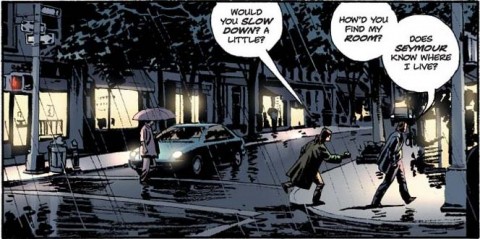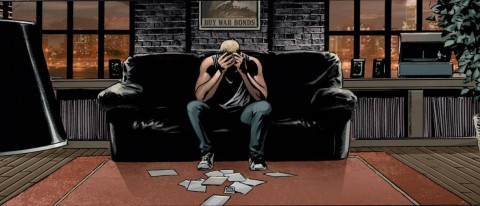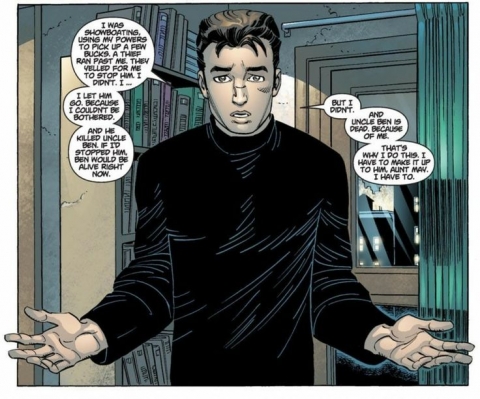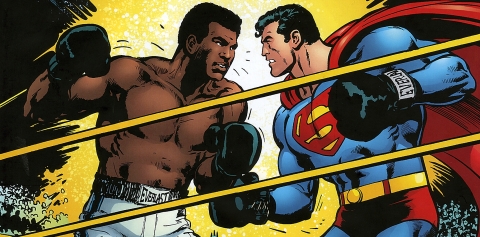52 weeks. 52 different writers. 2 trade paperbacks or hardcovers a week. Each week I’ll take a look at a different writer and read two different collected editions from within that person’s repertoire to help in the examination of their work. This week starts the glimpse at Ed Brubaker’s work, with today paying close attention to his mastery of the crime-noir genre in comics.
Ed Brubaker
Ed Brubaker has seemingly become synonymous with the words “crime-noir” and that’s likely due to the fact that he’s simply one of the best with the genre when it comes to comics. Teaming with frequent collaborator Sean Phillips, Brubaker more often than not leaves a mark with his dark crime stories producing quality work in series like Criminal, Fatale and most recently, The Fade Out. Anytime Brubaker and Phillips team up to give you a story, you just know you’re in for a treat. Today’s look at their work on Criminal is a fine example of the two men at their best, having won multiple Eisner awards for their work on the series.
Criminal – Volume 1: Coward
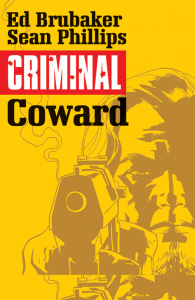 Criminal – Volume 1 follows Leo Patterson, an ace pickpocket and master strategist, as he tries to get on with his life five years after one of his big heists went south. Leo receives a blast from his past as he encounters Seymour, one of the survivors of the horrible “Salt Bay” job, and a crooked cop named Jeff, who try to recruit him for a job that would rake in millions of dollars worth of diamonds. Leo is initially apprehensive about working with Seymour because of the set of rules he follows that ensures he always make it out of a heist alive, one way or another. Seymour exploits the emotional side of Leo, using Greta, a former heroin addict and fellow criminal who has worked heists with Leo in the past, to convince Leo to work the job.
Criminal – Volume 1 follows Leo Patterson, an ace pickpocket and master strategist, as he tries to get on with his life five years after one of his big heists went south. Leo receives a blast from his past as he encounters Seymour, one of the survivors of the horrible “Salt Bay” job, and a crooked cop named Jeff, who try to recruit him for a job that would rake in millions of dollars worth of diamonds. Leo is initially apprehensive about working with Seymour because of the set of rules he follows that ensures he always make it out of a heist alive, one way or another. Seymour exploits the emotional side of Leo, using Greta, a former heroin addict and fellow criminal who has worked heists with Leo in the past, to convince Leo to work the job.
There are so many things at play when it comes to this first volume of Criminal. It’s a brilliant crime story that takes itself seriously and paces itself out in a way that keeps you turning the page. The themes of betrayal, love, greed and consequence are all on the table as this story charges full throttle to the very end. Even when the story points out the obvious turn it is going to take, it still ensures that it twists in one way or another that surprises you. You know that a crime story just isn’t exciting unless something goes wrong and threatens the success of the criminals but it is the way that Brubaker not only threatens the main character, Leo, that makes this story so exciting to read, it’s also the way he puts every other character under duress as well.
The characters are what make Criminal so rich as these characters who are criminals drive the story and every action taken. It’s the old writing ideology that action informs character and character informs the action. Brubaker submits to the symbiotic nature the two story elements share and builds beautifully tragic characters from it all. Leo is the man with the plan, always prepared to take every precaution to ensure the heists he’s planned go off without a hitch. Even then though, Leo always has a back up plan to cover his own behind in case everything falls apart, making him a coward first and a genius second, something that all the characters who know Leo are aware off. It’s the cowardice of Leo that his enemies prey on as his fear makes him predictable and always place him under the threat of fearing to fail. Characters like Seymour or Jeff, who are con men or crooked cops, face threats from different areas that include fear and self preservation but also of incurring the wrath of others who sit higher on the proverbial food chain than they do. Someone like Greta, who has a dark past, is driven to succeed so that she ensures her future so that she can look after her daughter and as a result build a future for both of them. It’s the characters, their motivations and their actions to succeed that keep you hooked from the first page all the way to the last.
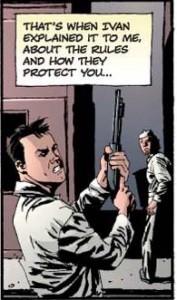
Brubaker uses a pretty straight forward set of dialogue to keep things moving throughout this one. The characters speak like cowards, scoundrels and people who generally just want to survive or get paid. No one in this story is a hero and it reflects in the way they speak. Even then, the one character who might fall to the side of somewhat “good” because of the way they handle certain situations in the story still manages to talk like a bit of a thug as they’re a person who just manages a bar for lowlifes at the end of the day. There’s plenty of cussing and dirty talk laced into the story which does only compliment how things unfold when a character deviates from the normal speech patterns you’re presented. As I said above Leo is a coward and only out for himself so it is a lot of fun to watch how he handles himself in a conversation where he’s planning a heist versus when he is trying to ensure he survives. The contrast in how Leo speaks in these instances is so powerful because of how different they are from one situation to the next.
As great of a story that Criminal is, it does still fall victim to some tragic storytelling pitfalls that could make or break the story in some cases. The biggest complaint I could muster up towards the first volume of Criminal is the overall conclusion to this story as you do and do not get a sense of closure at the same time. With a story like Criminal it really isn’t much of a spoiler to state that a lot of characters end up six feet under and when I say a lot, I really have to stress the A LOT part. But in a medium where death is the most overused plot device available you can’t help but feel like having a character die is the most unrewarding type of resolution. There are plenty of writers who claim using death as a form of resolution for the story is just lazy as you don’t resolve anything, you just end it. The most rewarding style of resolution is the type where you write your character into an insurmountable corner and have them survive the ordeal in a creative manner, not kill the character off because they’re stuck in the corner with no conventional way out. The writing is so on point throughout this volume, with the character work being superb, it is just unfortunate that the punctuating mark on a lot of this character work is death.
Speaking of punctuating mark, it has to be said how integral an artist like Sean Phillips is when it comes to a project like this. I’ve deviated from my formula a few times before by speaking a bit about the artist on the book instead of the writer but it’s necessary in instances like this wherein the writer creates a mood for the story but the artist sets it. Together Ed Brubaker and Sean Phillips are a seemingly unbeatable Crime-Noir team that no one can touch and this collection is about as great of evidence as that as you’ll find anywhere else in comics.
Collects: Criminal #1-5.
Best Character: Leo Patterson.
Best Line Of Dialogue/Caption: “But the way I see it…if you aren’t scared, in our line of work, then you just aren’t thinking. And I won’t work with people who don’t use their brains before their bullets…as a rule, at least.” – Leo Patterson.
Best Scene/Moment: The Heist – Issue 2.
Best Issue: Issue 2. This issue is where your average crime story would decide to really climax. Issue 2 is when Leo and the crew try to steal the diamonds. You get the planning, execution and the fall out of the heist all in one issue which results in a comic that you could read on it’s own a hundred different times and still enjoy it. To pack all of that into one issue would be too much for some writers but Brubaker somehow manages to find the absolutely perfect balance between everything that’s going on in this issue. In two issues they pull of the heist while the other remaining ones deal with the fallout and this issue isn’t even what I’d call the climax of events. It only goes uphill from here.
Why You Should Read It: Criminal is Ed Brubaker doing the crime-noir genre to the highest degree possible and this is only the start of many great stories! You will be hard sought to find a more well written series of crime stories than what you find when you first pick up Criminal. It’s serious storytelling in the comic medium so this is the type of story I’d recommend to anyone who says “comics are for kids” because trust me, this volume shoots that argument in both kneecaps before taking it out back and putting it down like Old Yeller. If you want a great all around comic, pick up something with Brubaker’s name on it. If you want a great crime story though, pick up something with Brubaker’s AND Phillip’s names on it.
Captain America: The Winter Soldier Ultimate Collection
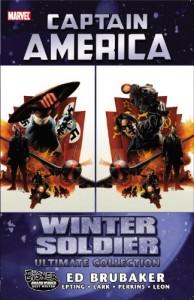 Ed Brubaker spent nearly eight years writing the character of Captain America for Marvel Comics. The run is widely considered one of the best with said character and maybe even one of the better runs with any Marvel character over the last decade. During his time with Captain America, Brubaker enhanced some of the staple characters from within his cast including Agent 13, Crossbones and the Red Skull. One of the most important parts of Brubaker’s run was the introduction of a character called The Winter Soldier, a mysterious man who had ties to Captain America’s past. Brubaker’s creation of the Winter Soldier would prove to be far more influential than anyone could’ve ever imagined as the character’s prominence and popularity has never been higher than it is right now following the release of a major motion picture based on the very storyline we’ll be looking at today.
Ed Brubaker spent nearly eight years writing the character of Captain America for Marvel Comics. The run is widely considered one of the best with said character and maybe even one of the better runs with any Marvel character over the last decade. During his time with Captain America, Brubaker enhanced some of the staple characters from within his cast including Agent 13, Crossbones and the Red Skull. One of the most important parts of Brubaker’s run was the introduction of a character called The Winter Soldier, a mysterious man who had ties to Captain America’s past. Brubaker’s creation of the Winter Soldier would prove to be far more influential than anyone could’ve ever imagined as the character’s prominence and popularity has never been higher than it is right now following the release of a major motion picture based on the very storyline we’ll be looking at today.
Captain America: The Winter Soldier follows Captain America months after the tragic disbanding of the Avengers in “Avengers: Disassembled”. Steve Rogers has become slightly unhinged as well as reckless in the way he deals with threats, with no regard for evil doers’ health and only wanting to get the job done as quickly as well as effectively as possible. When a villain from Captain America’s past begins to rear their head, Cap can’t help but shake an awful feeling of something not being right. After discovering a plot to attack several different cities, Captain America learns that a legendary myth surrounding a man called “The Winter Soldier” might be less of a myth and more closer to the truth. But it’s the truth surrounding who the Winter Soldier truly is that threatens to harm Cap in a way of which he’s never been harmed before.
Brubaker appears to be as content with building Steve Rogers up as he does with tearing him down, putting the man through countless trials and tribulations all the way through this Winter Soldier story. It is brilliant character work all around the table thanks to Brubaker as we get a vast array of emotions and developments from almost all the main characters who appear here. With Steve, Brubaker spends as much time having him fail as he does succeeding, making Captain America feel more human, and most importantly easier to relate to, than he has ever been to readers before. To see Steve try so hard to thwart the plans of his villains only to come up short time and time again keeps you engaged because of the way it builds him up for redemption only to then have Brubaker dance on your parade by making Cap lose even when he wins. It’s a vicious cycle that inevitably only compliments the main character as the story feels believable even as it asks you to suspend your disbelief.
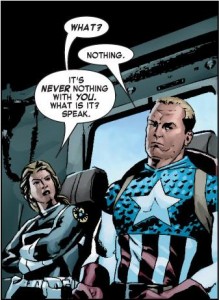
The plotting throughout this series of stories is most comparable to a wick of a candle, slowly burning down and leaving a trail of melted wax behind it. The story moves along at a pace that gives you small pieces as it progresses and with every clue that threatens to resolve the mystery, more damage is done to the lives of the characters. Brubaker is methodical in the paces he takes as you get further into the story, wisely plotting out certain plot points at the perfect time to make you take that next step to find out what happens next. Each moment feels deliberate in the way it exposes some form of truth to you, being certain to never be too slow moving of a story that you lose interest but also careful to not move so quickly that you feel like you’re experiencing a tour-de-force through Captain America’s past. The end result is a thick story that encourages you to keep reading even when you try to mediate how much you take in. Brubaker’s major reveals all hit at appropriate intervals to give the story a satisfying payoff.
As much as I praise the pace at which Brubaker exposes important story moments, there are a handful of instances where the plotting feels just slightly peculiar. There are several times throughout the story where Brubaker chooses to show rather than tell and that results in other parts of the story feeling like they weren’t given enough panel time. A prime example is how an event will unfold in a manner that doesn’t really need explaining only for the action to cut back to a moment before and explain why things broke down in that manner. Honestly, most people prefer to see what happens instead of just being told it but in these few instances it would’ve helped the flow of the issues to either include these glimpses at why things happened the way they did in the present time or just before the action kicks off. Instead, you end up wasting a page or two explaining something that felt rather arbitrary when those extra pages could’ve been used else where to flesh out the story more.
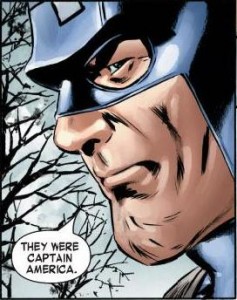
One of the most brilliant parts of this entire volume is how Brubaker provides a great jumping on point for new readers while still making this a book for people who already love Captain America. The entire Winter Soldier storyline draws heavily upon Captain America’s history, referencing past teammates and partners as well as missions. In most cases, an intimate glimpse at a character with such a rich past could alienate readers but instead Brubaker uses it as the ace up his sleeve, seeding in moments that were technically off the record but still fall within the confines of Captain America’s continuity. This way new readers get a history lesson that doesn’t feel convoluted while older readers get a few “Ah Ha!” moments that payoff years of commitment.
Brubaker definitely plays the long game with this volume, as well as with his entire run as a whole, setting up stories for the Captain America title for years to come beyond the Winter Soldier storyline. The seeds of future story lines are definitely planted here but not necessarily paid off, which can be considered both a good or a bad thing depending on the type of reader you are. There are some major moments that conclude issues in this volume to set up future story lines that are paid off dozens of issues later so in some regards you don’t get a complete story every issue. On the other hand it is all part of a much larger and brilliant tapestry orchestrated by Brubaker that ultimately pays off in spades later on down the road. The Winter Soldier story itself gets a fairly decent conclusion here where you can read this volume and be happy when you put it down knowing that you got a better understanding of who the Winter Soldier is. If you like the story enough you’ll absolutely be pulled in for the long run to see how Brubaker’s epic run with both Captain America and the Winter Soldier unfolds. At the end of the day, Brubaker shows a masterful ability to develop a long running story that will more likely than not keep you hooked ’til the bitter end.
Collects: Captain America #1-9, 11-14.
Best Character: Captain America.
Best Line of Dialogue/Caption: “…Just like Captain America has symbolic value, an American teenager fighting alongside him…that’s a powerful symbol, too…and if he gets his hands a little dirtier than most soldiers when no one’s looking…well, that’ll be our secret right?” – Unnamed US Army General.
Best Scene/Moment: Captain America in a race against time to save Philadelphia – Issue 6.
Best Issue: Issue 14. The conclusion of this collection is the most satisfying issue of the bunch simply because of how it pays off everything Brubaker built up in the other twelve issues of this collection. You feel as though a weight is lifted off your shoulders when the inevitable showdown between Captain America and the Winter Soldier finally takes place. The battle is worth the wait as there’s just as many brutal punches thrown as there are words. It’s a highly emotive issue that is packed with action and character developments that paves the way for future stories. Let’s not forget the final page of the volume that twists in a way you’d never expect if you’re just reading this story for the first time. It puts an entirely new light on the story you just read and might even make you have to go back to see all the clues that were laid out for you.
Why You Should Read It: Ed Brubaker’s run on Captain America was a pivotal turning point in his career that gained him a high amount of popularity and it all begins with this collection of stories. It isn’t the typical crime-noir type of story that you’d expect from someone like Brubaker, instead replacing that genre with plenty of historical intrigue and mystery that slowly builds to a boiling point that changes Captain America’s life for years to come. Brubaker does great things here with Cap, fitting pieces of untold stories into the character’s history that not only compliments his past but enhances it.

